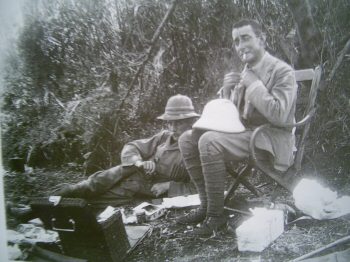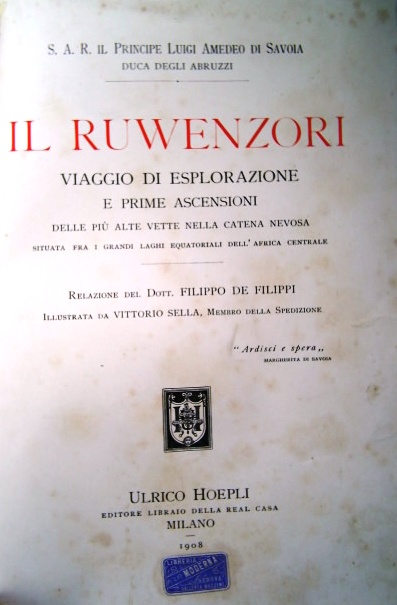|
The Duke of Abruzzi
 Luigi
Amedeo di Savoy, Duke of Abruzzi [1873 - 1933]
was born in Madrid to the then king of Spain also a
Savoy, who abdicated his throne only a few weeks after
his son's birth and returned to Italy. When he was six
years old, young Luigi was assigned to the Italian Navy
and received his entire education in military schools.
A man of great energy and imagination, at the age of
24 he organised and led the expedition that made the
first ascent of Mount St Elias [5,484 metres] in Alaska
in 1897. Luigi
Amedeo di Savoy, Duke of Abruzzi [1873 - 1933]
was born in Madrid to the then king of Spain also a
Savoy, who abdicated his throne only a few weeks after
his son's birth and returned to Italy. When he was six
years old, young Luigi was assigned to the Italian Navy
and received his entire education in military schools.
A man of great energy and imagination, at the age of
24 he organised and led the expedition that made the
first ascent of Mount St Elias [5,484 metres] in Alaska
in 1897.
Two years later he led an expedition to the North Pole
which reached a latitude 86^34' north, a new record
at the time. In 1906 he led the Rwenzori expedition
which climbed all the major peaks and made the most
extensive exploration of the range before or since.
A few years later, in 1909, he organised an expedition
to the Karakoram and set the record to the highest altitude
yet achieved by ascending the second highest mountain
in the world, K2, to a height of about 7,500 metres
[24,600 feet], along the route that today bears his
name, the Abruzzi ridge. On the same journey he increased
this record when he ascended Chogolisa (Bride Peak)
to an even higher altitude, 7.654 metres (about 25.110
feet), but did not reach the summit.
The first ascent to the summit of Chogolisa was not
made until 45 years later. During his great period of
adventure and exploration, the Duke of Abruzzi remained
a professional naval officer and on 30 September 1911
he commanded the squadron that attacked Preveza, Greece,
in the first action of the Italian – Turkish War.
Later, he commanded the Adriatic fleet of the Italian
navy in World War I and is warmly remembered in Italy
for his heroic rescue of more than 100.000 Yogoslav
refugees from Albania. In his last years he became interested
in the exploration and agricultural development of Somalia
and Ethiopia, eventually marrying a Somali wife. After
several expeditions to the region and the establishment
of various agricultural schemes, he died in Ethiopia
on 18th March 1933, where he was buried. In the 1980th
the Duke’s family hoped to have his remains exhumed
and returned to Italy, but bowed to the wishes of the
Ethiopian villagers who refused to allow the exhumation,
wanting to keep his remains – and memory –
with them.
From
“Uganda Rwenzori –
A range of Images”, by David Pluth, 1996
Little Wolf Press, Switzerland.
Luigi Amedeo Duke
of Abruzzi was the third born of Amedeo
(1845-1890), first Duke of Aosta and king of Spain from
1870 to 1873. He does not have direct heirs, but the
Aosta line is today represented by the fifth Duke of
Aosta, Amedeo, born in 1943. Amedeo
has already visited Uganda on the occasion of the 90th
celebrations that took place in 1996 and he shall be
once again in Uganda on the occasion of the Centenary.

Luigi Amedeo of Savoy , duke of Abruzzi together
with A.F
Knowles at the feet of the Rwenzori in 1906.
THE DUKE OF ABRUZZI
AND AFRICA
By Mirella Tanderini
Until the First World
War, the Duke of Abruzzi enjoyed an enormous popularity,
both in Italy and abroad for his success in expeditions.
After the war the duke retired from the navy and all
his efforts aimed at building a farming colony in Somalia
with the co-operation of Somali people. It was a dream
he had nourished for a long time, since he first set
his foot on the African coast in 1883 and fell in love
with the Continent.
He succeeded in raising funds to reclaim land, build
dams, roads and a railroad, factories and houses, schools,
a fully equipped hospital, a Catholic church and a Mosque
for 3.000 people living and working in the village that
was called after his name.
His last expedition, in 1928, was to locate the sources
of Uebi-Scebeli, the river on which his village was
built, and to map the whole region down from Ethiopia
highlands to the coastal Somalia. He spent his last
days in his village and he wanted to be buried there,
in the Continent he loved. His experiment of co-operation
between European capital and technologies and African
resources and labour was scarcely understood at this
time, but the company he had set up went on successfully
also after his death. When Somalia became independent
it was nationalised and until 1992, when it was ravaged
by civil was, it continued to be the major producer
of sugar in the country.
 After the Second World War, Italy became a Republic
and that perhaps was one of the reasons why the Duke
of Abruzzi was forgotten by his own fellow country men.
Luigi Amedeo, Duke of Abruzzi was a Prince of the Crown
and a cousin of the King Vittorio Emanuel III of Savoy
that had allowed Fascism to rule Italy and to ally with
the Nazi regime of Germany, and although he personally
never approved of Mussolini and kept away from politics,
the citizens of the new Republic preferred to forget
about all the Savoys and for fifty years the Duke of
the Abruzzi was scarcely mentioned in encyclopaedias
and books on exploration and mountaineering.
After the Second World War, Italy became a Republic
and that perhaps was one of the reasons why the Duke
of Abruzzi was forgotten by his own fellow country men.
Luigi Amedeo, Duke of Abruzzi was a Prince of the Crown
and a cousin of the King Vittorio Emanuel III of Savoy
that had allowed Fascism to rule Italy and to ally with
the Nazi regime of Germany, and although he personally
never approved of Mussolini and kept away from politics,
the citizens of the new Republic preferred to forget
about all the Savoys and for fifty years the Duke of
the Abruzzi was scarcely mentioned in encyclopaedias
and books on exploration and mountaineering.
It is the merit of the Kampala Conference (April 1996)
to have anticipated a revival of interest for the Duke
of Abruzzi on the occasion of the 90th anniversary of
the Rwenzori expedition. There is a wealth of documentary
material surviving: the accounts of the Duke’s
expeditions, the book of Filippo de Filippi containing
the extraordinary photos of Vittorio Sella (he was developing
the photos in a tent working as dark room while up on
the mountains), the maps and all the documents kept
by the Fondazione Sella at Biella and in the Museum
“Duca degli Abruzzi” in Turin and in the
archives of foundations, alpine clubs and geographic
societies all over the world. The Canadian writer Michael
Shandrick and myself wrote a book on the life of the
Duke. The ascent and the exploration of the Rwenzori
massif is one of the most fascinating chapter in the
book and we, the authors, are pleased that the celebrations
for the Duke of Abruzzi started in the Continent that
was the country of his choice in a period of history
when Europeans considered it as a territory to conquer
and exploit. It is a most significant event and the
starting point of new studies and conferences that will
render justice to a great explorer who was neglected
for too long.
The above article was written by the Italian
historian Mirella Tanderini on the occasion of the celebrations
of the 90th anniversary of the Duke’s expedition
organized by the Department of Geography of Makerere
University, 1996.
|
